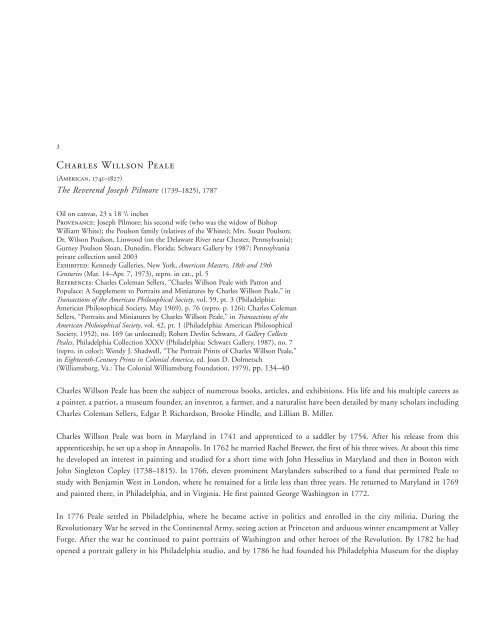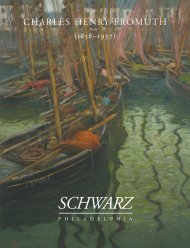pdf - Schwarz Gallery
pdf - Schwarz Gallery
pdf - Schwarz Gallery
You also want an ePaper? Increase the reach of your titles
YUMPU automatically turns print PDFs into web optimized ePapers that Google loves.
3<br />
Charles Willson Peale<br />
(American, 1741–1827)<br />
The Reverend Joseph Pilmore (1739–1825), 1787<br />
Oil on canvas, 23 x 18 3 /4 inches<br />
Provenance: Joseph Pilmore; his second wife (who was the widow of Bishop<br />
William White); the Poulson family (relatives of the Whites); Mrs. Susan Poulson;<br />
Dr. Wilson Poulson, Linwood (on the Delaware River near Chester, Pennsylvania);<br />
Gurney Poulson Sloan, Dunedin, Florida; <strong>Schwarz</strong> <strong>Gallery</strong> by 1987; Pennsylvania<br />
private collection until 2003<br />
Exhibited: Kennedy Galleries, New York, American Masters, 18th and 19th<br />
Centuries (Mar. 14–Apr. 7, 1973), repro. in cat., pl. 5<br />
References: Charles Coleman Sellers, “Charles Willson Peale with Patron and<br />
Populace: A Supplement to Portraits and Miniatures by Charles Willson Peale,” in<br />
Transactions of the American Philosophical Society, vol. 59, pt. 3 (Philadelphia:<br />
American Philosophical Society, May 1969), p. 76 (repro. p. 126); Charles Coleman<br />
Sellers, “Portraits and Miniatures by Charles Willson Peale,” in Transactions of the<br />
American Philosophical Society, vol. 42, pt. 1 (Philadelphia: American Philosophical<br />
Society, 1952), no. 169 (as unlocated); Robert Devlin <strong>Schwarz</strong>, A <strong>Gallery</strong> Collects<br />
Peales, Philadelphia Collection XXXV (Philadelphia: <strong>Schwarz</strong> <strong>Gallery</strong>, 1987), no. 7<br />
(repro. in color); Wendy J. Shadwell, “The Portrait Prints of Charles Willson Peale,”<br />
in Eighteenth-Century Prints in Colonial America, ed. Joan D. Dolmetsch<br />
(Williamsburg, Va.: The Colonial Williamsburg Foundation, 1979), pp. 134–40<br />
Charles Willson Peale has been the subject of numerous books, articles, and exhibitions. His life and his multiple careers as<br />
a painter, a patriot, a museum founder, an inventor, a farmer, and a naturalist have been detailed by many scholars including<br />
Charles Coleman Sellers, Edgar P. Richardson, Brooke Hindle, and Lillian B. Miller.<br />
Charles Willson Peale was born in Maryland in 1741 and apprenticed to a saddler by 1754. After his release from this<br />
apprenticeship, he set up a shop in Annapolis. In 1762 he married Rachel Brewer, the first of his three wives. At about this time<br />
he developed an interest in painting and studied for a short time with John Hesselius in Maryland and then in Boston with<br />
John Singleton Copley (1738–1815). In 1766, eleven prominent Marylanders subscribed to a fund that permitted Peale to<br />
study with Benjamin West in London, where he remained for a little less than three years. He returned to Maryland in 1769<br />
and painted there, in Philadelphia, and in Virginia. He first painted George Washington in 1772.<br />
In 1776 Peale settled in Philadelphia, where he became active in politics and enrolled in the city militia. During the<br />
Revolutionary War he served in the Continental Army, seeing action at Princeton and arduous winter encampment at Valley<br />
Forge. After the war he continued to paint portraits of Washington and other heroes of the Revolution. By 1782 he had<br />
opened a portrait gallery in his Philadelphia studio, and by 1786 he had founded his Philadelphia Museum for the display



